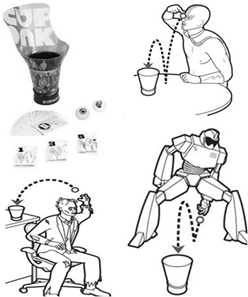题目内容
5.Can you believe your eyes?A recent experiment suggests that the answer to that question may depend on your age.Martin Doherty,a psychologist at the University of Stifling in Scotland,led the team of scientists.In this experiment,Doherty and his team tested the perception(观察力) of some people,using pictures of some orange circles.The researchers showed the same pictures to two groups of people.The first group included 151 children aged 4 to 10,and the second group included 24 adults aged 18 to 25.
The first group of pictures showed two circles alone on a white background.One of the circles was larger than the other,and these people were asked to identify the larger one.Four-year-olds identified the correct circle 79 percent of the time.Adults identified the correct circle 95 percent of the time.
Next,both groups were shown a picture where the orange circles,again of different sizes,were surrounded by gray circles.Here's where the trick lies in.In some of the pictures,the smaller orange circle was surrounded by even smaller gray circles--making the orange circle appear larger than the other orange circle,which was the real larger one.And the larger orange circle was surrounded by even bigger gray circles--so it appeared to be smaller than the real smaller orange circle.
When young children aged 4 to 6 looked at these tricky pictures,they weren't fooled-they were still able to find the bigger circle with roughly the same accuracy as before.Older children and adults,on the other hand,did not do as well.Older children often identified the smaller circle as the larger one,and adults got it wrong most of the time.
As children get older,Doherty said,their brains may develop the ability to identify visual context(背景).In other words,they will begin to process the whole picture at once:the tricky gray circles,as well as the orange circle in the middle.As a result,they're more likely to fall for this kind of visual trick.
71.Doherty and his team of scientists did an experiment to evaluate.D
A.children's and adults'brains
B.children's and adults'eye-sight
C.the influence of people's age
D.people's ability to see accurately
72.When asked to find the larger circle,.C
A.adults got it right most of the time with gray ones around
B.children at 6 got it wrong 79%of the time with no gray ones around
C.children at 4 got it right about 79%of the time with gray ones around
D.only adults over 1 8 got it right 95%of the time with gray ones around
73.According to the passage,we can know that.A
A.a circle surrounded by bigger ones looks smaller than its real size
B.an orange circle appears bigger than a gray one of the same size
C.a circle surrounded by other circles looks bigger than its real size
D.a smaller orange circle appears bigger on a white background
74.Visual context may work when children get older than.B
A.4 B.6 C.10 D.18
75.Why are younger children not fooled?D
A.Because older people are influenced by their experience.
B.Because they are smarter than older children and adults.
C.Because people's eyes become weaker as they grow older.
D.Because their brains can hardly notice related things together.
分析 本文是一篇说明文,讲述了观察力与年龄有关,年龄不同,观察力也不同.
解答 DCABD
71 D 细节题.根据第二段In this experiment,Doherty and his team tested the perception(观察力) of some people,描述,可知做实验的目的是评估让你们的观察能力,故选B
72 C 细节题.根据第三段Four-year-olds identified the correct circle 79 percent of the time.…Next,both groups were shown a picture where the orange circles,again of different sizes,were surrounded by gray circles.描述,可知当被要求找出大圆圈时,四岁的孩子的准确率是79%,故选C
73 A 细节题. 根据第三段Four-year-olds identified the correct circle 79 percent of the time.Adults identified the correct circle 95 percent of the time.描述,可知被大圆圈包围的圆看起来要比真实小一些,故选D
74 B 推理判断题. 根据As children get older,Doherty said,their brains may develop the ability to identify visual context.In other words,they will begin to process the whole picture at once:及上文When young children aged 4 to 6 looked at these tricky pictures,they weren't fooled-they were still able to find the bigger circle with roughly the same accuracy as before.描述,可知孩子们六岁多的时候视觉语境开始起作用,故选B
75 D 推理判断题.根据they were still able to find the bigger circle with roughly the same accuracy as before.描述,可知小孩子没有被愚弄的原因是他们的大脑几乎不会注意到它们的联系,故选D
点评 考察学生的细节理解和推理判断能力,做细节理解题时一定要找到文章中的原句,和题干进行比较,再做出正确的选择.在做推理判断题不要以个人的主观想象代替文章的事实,要根据文章事实进行合乎逻辑的推理判断.

 We all have our wish lists,whether it is for the holiday season,a birthday or a get-together.The fact is that we are all human and we all desire nice things and fun things.One thing that should not be missed is putting Cuponk on your wish list so that you can have years of fun and entertainment.
We all have our wish lists,whether it is for the holiday season,a birthday or a get-together.The fact is that we are all human and we all desire nice things and fun things.One thing that should not be missed is putting Cuponk on your wish list so that you can have years of fun and entertainment.